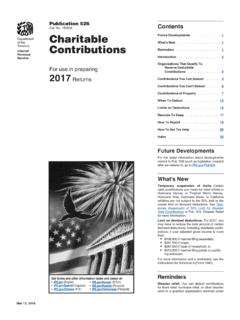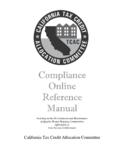Transcription of Fiscal Sponsorship
1 PRESENTATION on Fiscal Sponsorship Western Conference on Tax exempt Organizations November 17, 2006 Los Angeles Gregory L. Colvin, Esq. Silk, Adler & Colvin San Francisco Thirteen years ago, in 1993, the book Fiscal Sponsorship : 6 Ways To Do It Right, was published after a period of controversy in the nonprofit world about an arrangement often called Fiscal agency. This term actually referred to several different constructs, but the common theme was that some enterprising person or group wished to conduct a charitable program (and attract tax-deductible contributions), but without incorporating or obtaining Internal Revenue Service (IRS) recognition of the project s Internal Revenue Code (IRC) Section 501(c)(3) tax exemption. An existing 501(c)(3) Fiscal agent would be recruited to receive grants and donations to support the project, which would then be disbursed in the form of payments to employees, vendors, contractors, or grantees.
2 These arrangements, if not handled carefully, were vulnerable to the criticism that they were mere conduits for the transmission of deductible donations to entities not qualified to receive them. Since the publication of the book, the term Fiscal Sponsorship has developed as a more appropriate label for these arrangements. In the last decade, the phenomenon of Fiscal Sponsorship has become common, widespread, and quite reputable. It has become a popular ancillary activity for public charities involved in human service, environmental, and artistic endeavors. Nonprofit institutions solely devoted to Fiscal Sponsorship have sprung up across the country, ranging from documentary film sponsors to public health research groups to separate corporations spun off by community foundations. A revised edition of Fiscal Sponsorship was published in December 2005.
3 Gregory L. Colvin, Fiscal Sponsorship : 6 Ways To Do It Right, Study Center Press, 1095 Market Street, Suite 602, San Francisco, California 94103, telephone 415-626-1650, fax 415-626-7276 (1993, 2005). See also 2 I. Fiscal AGENCY V. Fiscal Sponsorship In the early 1990 s, a series of discussions occurred among private foundations and public charities concerned about how to maximize the ability of the philanthropic community to support a wide variety of important activities ranging from arts to international aid, from environmental activism to individual health needs, and a host of other human services. The discussions centered on the future of that funding practice widely (and unfortunately) known as Fiscal agency. That practice was criticized and rightfully Some organizations considered abandoning the practice. Most continued it, however, for the compelling reason that the charitable sector would be crippled without a way to harness the creativity and respond to the needs of a vast array of groups and individuals that lack the tax status required to receive grants from many private foundations, government agencies, and other funders.
4 Taking a positive approach to the problem, it is possible to describe six different models by which a public charity, tax- exempt under IRC Section 501(c)(3), can conduct a program of support to individuals and to nonexempt organizations that is legal and proper. First of all, a change in terminology is needed to reflect the proper relationships. This arrangement should not be called Fiscal agency, because the charity is not, and should not be, the legal agent of the nonexempt project. Under the law of agency, an agent acts on behalf of another (the principal) who has the right to direct and control the activities of the agent. Calling a charity a Fiscal agent implies that the project controls the charity. To comply with tax- exempt law, the relationship must be the reverse; the charity must be in the controlling position, and the nonexempt project must act so as to further the charity s exempt purposes.
5 Fiscal Sponsorship is now considered to be the more accurate and acceptable term. It implies, correctly, that the charity has made a choice to support the nonexempt project financially. Fiscal Sponsorship arrangements typically arise when a person or group (a project) wants to get support from a private foundation or a government agency, or tax-deductible donations from individual or corporate donors. By law or preference, the funding source will only make payments to organizations with 501(c)(3) tax status. So the project looks for a 501(c)(3) sponsor to receive the funds and pass them on to the project. However, the IRS has a strict policy against conduit arrangements. When a donation is made by X to Y, earmarked for Z, it is in reality a donation from X to Z, and if Z is not exempt under Section 501(c)(3), the gift is not a tax-deductible contribution.
6 To be deductible, the 1 See, for example, Use of Fiscal Agents: A Trap for the Unwary, by John A. Edie, Council on Foundations (1989). 3 IRS requires that Y (the sponsor) have complete discretion and control over the funds, and holds Y legally responsible to see that its payments to Z (the project) are made to further Y s tax- exempt purposes. As the models demonstrate, Fiscal Sponsorship advantages are not limited to situations where the project lacks, or never will have, 501(c)(3) status. Fiscal Sponsorship is often used for that temporary period before a new organization obtains its own tax exemption. Other variations occur when a small 501(c)(3) group needs the help of a larger 501(c)(3) organization to manage its financial affairs or seeks IRS classification as a public charity based on the relationship with the sponsor.
7 The six models are not etched in stone. They are simply devices for understanding the possibilities. Each model is really a paradigm with certain unique characteristics. In practice, they may be used in combinations, blended, subdivided, and they may serve as springboards for developing new models. II. SUMMARY OF THE MODELS The models summarized in the table below are all legal ways in which a project can derive some benefit from a relationship with a sponsor. The table places the model with the least financial independence for the project at the top (Model A, Direct Project) and the model with the most financial independence for the project at the bottom (Model F, Technical Assistance). In Model A, the sponsor takes the project in-house. The project has no separate legal existence. The originators of the project may have approached the sponsor with a program idea that had not been part of the sponsor s activities in the past, but once the sponsor adopts it as a staff project, it belongs completely to the sponsor.
8 Model A is probably the most common form of institutionalized Fiscal Sponsorship . These Fiscal sponsors see themselves often as incubators for new charities, or umbrella organizations permitting several related projects to exist in one tax- exempt corporation. Model A provides the most control over the project, and so it is the best training ground for start-up projects and is the least exposed to IRS challenge. Some legal problems do occur, however, when the project decides to go off on its own, if the sponsor and project do not have a clear understanding, at the outset, of what the terms of eventual separation will be. The people conducting the project become employees or volunteers of the sponsor for the duration of the project. The project s expenses are paid directly by the sponsor to the vendor or supplier. This is so even if a separate bank account is set up for the project.
9 Models A (Direct Project) and B (Independent Contractor Project) are both arrangements where the project is an integral part of the sponsor s program activities. They differ 4 on the issue of whether the people conducting the project may be legally classified as independent contractors or whether they must be classified as employees. In Model B, the project belongs entirely to the sponsor, but the actual operation of the project is contracted out to a separate legal entity, which could be a person, a business firm, or some other type of organization. This arrangement differs from a grant (Model C), in that the sponsor wishes to maintain control over the ultimate results of the project. Model C (Pre-Approved Grant) is a grantor-grantee relationship between the sponsor and the project. This includes the one-time arrangement enabling a project to obtain the proceeds of a grant from a private foundation via a sponsor, as well as the ongoing arrangement where a sponsor receives and transfers funds to a project as funds are raised.
10 Model C is a very widespread, and widely misunderstood, form of Fiscal Sponsorship . Often, the sponsor and project are not aware that they have created a grantor-grantee relationship between them. The project may put a lot of energy into a grant request presented to the funding source in the name of the sponsor, to which the grant is then awarded. The sponsor disburses funds to the project, and everybody tends to see that grant as the only one. Actually, there are two levels of grant relationship that occur, which is why some refer to this model as regranting. It is best if the sponsor and project create their own grantor-grantee relationship before the funding source is approached. If there is a trap for the unwary among Fiscal Sponsorship arrangements, Model C is it. If the control mechanisms are not administered properly, Model C can collapse into a conduit or step transaction in which the IRS will disregard the role of the sponsor and declare that the funding source has, in effect, made a payment directly to a non-501(c)(3) project.







